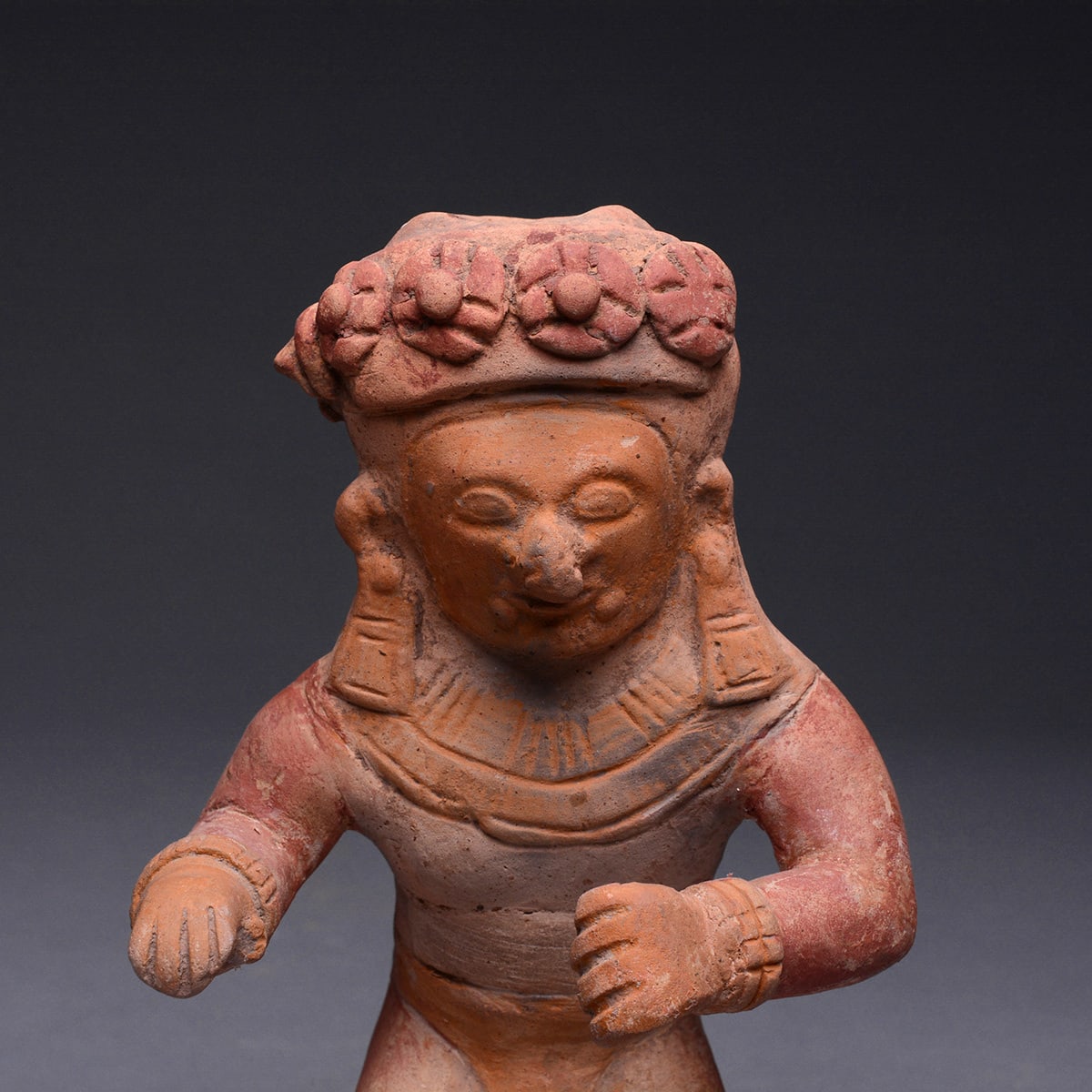Jama Coaque Terracotta Sculpture of a Dancing Shaman, 200 BCE - 600 CE
Terracotta
20.3 x 11.7 cm
8 x 4 5/8 in
8 x 4 5/8 in
PF.2565
Further images
The Pre-Columbian cultures of Ecuador are among the oldest in South America and among the first to master the art of pottery. Although we know little about the peoples themselves...
The Pre-Columbian cultures of Ecuador are among the oldest in South America and among the first to master the art of pottery. Although we know little about the peoples themselves or their traditions, historians have been able to piece together a picture of life in Ancient Ecuador thanks in part to the art and artifacts left behind. The culture of Valdivia created some of the oldest known works of art in the Americas. Situated along the coastal strip of Ecuador, the Valdivians established a thriving society that flourished for around two thousand years (from approximately 3500 to 1500 B.C.). Today they are famed for their small fertility figures, believed to be the earliest representational works of art in the Americas, first carved from stone, later formed from terracotta.
Hundreds of years later after the Valdivians disappear from the archaeological record appears another culture to which the name Chorrera has been attached (lasting from circa 1100-300 B.C.). Little is known about this culture; however, it is significant for its widespread geographical reach. As such, their artistic style greatly influenced those diverse cultures that began to emerge in the final centuries of the Chorrera period, a time historians have labeled the Period of Regional Development.
Among the most prominent cultures that flourished in the wake of the Chorrera are the cultures of Bahia, Jama Coaque, and La Tolita. Around 200 B.C., the Bahia developed along the coastal strip in the modern province of Manabi, lasting until approximately 600 A.D. Their earliest terracotta works were greatly indebted to the Chorrera; however, over the years a distinctive style emerged characterized by large figures adorned with detailed dress and body ornamentation.
Bahia is closely related to the culture known as Jama Coaque, sharing a similar style and common chronology. They inhabited the forested hills lining the coast of northern Manabi. The city of San Isidro was their cultural and ceremonial center, featuring several temples surmounting a large pyramid. Similar to the Bahia, Jama Coaque is known for its large terracotta figures, typically sculptured in a variety actions and poses. Ceremonial figures are also well-know, typically formed with the arms held along their sides, palms facing outwards.
The ceramic traditions in Ecuador are some of the oldest in the new world, with discoveries of fired pottery dating to as early as 3000 B.C., evidencing a long ceramic sequence in this highly innovative culture. This Manabi male figure from the Jama Coaque period in Ecuador, demonstrates the ceramicists dexterous skill at manipulating the medium and their ability to create lively, imaginative works of figural art. The male shaman dancer figure stands before us, his sculpted body suspended in motion. With bent legs spread wide and arms held in front of him, we could imagine the ancient rhythms that set this figure in motion. A large headdress and tasseled ear ornaments add an element of drama to the shaman, enhancing his spirited nature. Harnessed energy and tremendous vitality are clearly evident in this ancient figure, his compelling presence a fascinating one to experience.
Hundreds of years later after the Valdivians disappear from the archaeological record appears another culture to which the name Chorrera has been attached (lasting from circa 1100-300 B.C.). Little is known about this culture; however, it is significant for its widespread geographical reach. As such, their artistic style greatly influenced those diverse cultures that began to emerge in the final centuries of the Chorrera period, a time historians have labeled the Period of Regional Development.
Among the most prominent cultures that flourished in the wake of the Chorrera are the cultures of Bahia, Jama Coaque, and La Tolita. Around 200 B.C., the Bahia developed along the coastal strip in the modern province of Manabi, lasting until approximately 600 A.D. Their earliest terracotta works were greatly indebted to the Chorrera; however, over the years a distinctive style emerged characterized by large figures adorned with detailed dress and body ornamentation.
Bahia is closely related to the culture known as Jama Coaque, sharing a similar style and common chronology. They inhabited the forested hills lining the coast of northern Manabi. The city of San Isidro was their cultural and ceremonial center, featuring several temples surmounting a large pyramid. Similar to the Bahia, Jama Coaque is known for its large terracotta figures, typically sculptured in a variety actions and poses. Ceremonial figures are also well-know, typically formed with the arms held along their sides, palms facing outwards.
The ceramic traditions in Ecuador are some of the oldest in the new world, with discoveries of fired pottery dating to as early as 3000 B.C., evidencing a long ceramic sequence in this highly innovative culture. This Manabi male figure from the Jama Coaque period in Ecuador, demonstrates the ceramicists dexterous skill at manipulating the medium and their ability to create lively, imaginative works of figural art. The male shaman dancer figure stands before us, his sculpted body suspended in motion. With bent legs spread wide and arms held in front of him, we could imagine the ancient rhythms that set this figure in motion. A large headdress and tasseled ear ornaments add an element of drama to the shaman, enhancing his spirited nature. Harnessed energy and tremendous vitality are clearly evident in this ancient figure, his compelling presence a fascinating one to experience.









